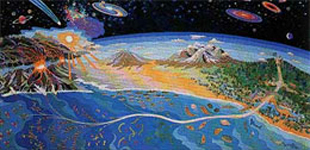Ian
Tattersall
American Museum of National History
Ian Tattersall is Curator Emeritus in the Division of Anthropology of the American Museum of Natural History in New York City. Trained in archaeology and anthropology at Cambridge, and in geology and vertebrate paleontology at Yale, he has worked on lemur systematics and ecology as well as in paleoanthropology, where his special interest has been in hominid diversity and cognitive evolution. Most recently, he has been concerned with trying to understand how a non-linguistic and non-symbolic ancestor gave rise to the cognitively unprecedented Homo sapiens, and what drove the exceptionally fast evolution of the human lineage over the course of the Pleistocene. He has done both primatological and paleontological fieldwork in countries as diverse as Madagascar, Vietnam, Surinam, Yemen and Mauritius. He has published more than 300 scientific papers, and in collaboration with Jeffrey Schwartz authored three volumes of The Hominid Fossil Record (2002-2005), a documentation in standardized descriptive and illustrative format of a large proportion of the most significant fossils that tell the human evolutionary story. Ian is also a prominent interpreter of human paleontology to the public, with several trade books to his credit, among them The Strange Case of the Rickety Cossack and Other Cautionary Tales from Human Evolution, The Brain: Big Bangs, Behaviors, and Beliefs (2012, with Rob DeSalle), Masters of the Planet (2012), Race? Debunking a Scientific Myth (2011, with Rob DeSalle), The World from Beginnings to 4000 BCE (2008), Becoming Human: Evolution and Human Uniqueness (1998) and The Fossil Trail: How We Know What We Think We Know About Human Evolution (1995, 2nd ed. 2009), as well as many articles in Scientific American and Natural History, and the co-editorship of the definitive Encyclopedia of Human Evolution and Prehistory. He lectures widely, and, as curator, has also been responsible for several major exhibits at the American Museum of Natural History, including Ancestors: Four Million Years of Humanity (1984); Dark Caves, Bright Visions: Life In Ice Age Europe (1986); Madagascar: Island of the Ancestors (1989); The First Europeans: Treasures from the Hills of Atapuerca (2003); and the highly acclaimed Hall of Human Biology and Evolution (1993) and its successor Hall of Human Origins (2007).
|
Paleoanthropology, the study of human evolution, has always followed a rather insular path. Most successful mammal families show a strong tendency to diversify, throwing off numerous species that all explore different aspects of their group’s evolutionary potential. Yet the fact that Homo sapiens is the lone hominid on the planet today tempts us, in contrast, to reconstruct our history by projecting that one single species back into the past in a linear sequence of increasingly primitive ancestors.
This scenario implies that we are the perfected products of long-term natural selection. But recent huge additions to the human fossil record show that our current lonely state is altogether unprecedented: up until a mere forty thousand years ago, several different hominid species typically coexisted on Earth, making our family a typical mammalian one. The fact that we have been able to eliminate the competition implies that there is something very novel about our species Homo sapiens, and particularly about the extraordinary way in which we process information. I conclude my talk by sketching a scenario of how this human uniqueness may have come about.
|
|



